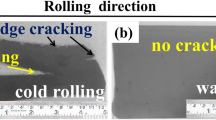Conclusions
-
1.
The character of deformation and fracture of carbon-plastic is qualitatively different for different modes of reinforcement.
-
2.
The stress-strain curves of a laminated angle-ply carbon-plastic with angles of reinforcement close to±45° are quite nonlinear in uniaxial tension. Longitudinal specimen strain at fracture amounts to ≈ 8–9%.
-
3.
The phenomenon of residual plasticity was observed in angle-ply carbon-plastic with fibers laid at angles close to±45°.
-
4.
The presence of several loading-unloading cycles has almost no effect on the appearance of the stress-strain curve of the carbon-plastic outside of these cycles.
-
5.
The area of the hysteresis loop, magnitude of plastic strain, and average elastic modulus of the loading- unloading cycle depend considerably on the initial stress level and mode of reinforcement of the material.
Similar content being viewed by others
Literature cited
G. M. Gunyaev, I. G. Zhigun, M. I. Dushin, I. A. Vorontsov, V. A. Yakushin, and A. F. Rumyantsev, “Dependence of elastic and strength characteristics of high-modulus composites on mode of reinforcement,” Mekh. Polim., No. 6, 1019–1027 (1974).
Yu. N. Rabotnov, G. M. Gunyaev, M. A. Kuznetsova, I. M. Makhmutov, and E. I. Stepanychev, “Nonlinear stress-strain functions for carbon-plastics with continuous static loading,” Mekh. Polim., No. 1, 49–53 (1976).
Z. T. Upitis and R. B. Rikards, “Strength and deformation properties of glass-plastic in plane stress in relation to structure of the reinforcement,” Mekh. Polim., No. 5, 848–859 (1978).
A. Rotem and Z. Hashin, “Failure modes of angle-ply laminates,” J. Compos. Mater.,9, 191–206 (1975).
O. Ishai and R. E. Lavengood, “The mechanical performance of bidirectional fiber-glass polymeric composites,” Isr. J. Technol.,8, No. 1–2, 101–109 (1970).
S. Amijima and T. Adachi, “Linear and nonlinear stess-train response of laminated composite materials. Part 2. Nonlinear stress-strain response,” Eng. Rev. Doshisha University,16, No. 3–4 (1975).
P. A. Zinov'ev and A. I. Tarakanov, “On the nonlinear deformation of laminated composite materials,” in: Use of Plastics in Machine Construction [in Russian], Moscow (1978), pp. 72–80.
K. Kawata, “On the yielding-fracture criterion of angle-ply FW laminates,” Mech. Behav. Mat., Proc. Int. Conf. Mech. Behav. Mat., Vol. 5 (1972), pp. 146–155.
R. Roulands, “Flow and the loss of load-carrying capacity,” in: News in Foreign Science. Mechanics. No. 16. Elastic Behavior of Composite Materials, Moscow (1978), pp. 140–179.
V. M. Andrienko, M. I. Dushin, E. P. Tolstobrov, A. M. Ermolaev, P. N. Nedoinov, and N. D. Toruteva, “Evaluation of the strength, stability, and weight efficiency of threelayer cellular panels with carbon-plastic sheaths,” Tr. Tsentr. Aerodinam. In-ta N. E. Zhukovskogo, No. 1815, 3–30 (1977).
Author information
Authors and Affiliations
Additional information
Translated from Mekhanika Kompozitnykh Materialov, No. 2, pp. 241–245, March–April, 1980.
Rights and permissions
About this article
Cite this article
Zinov'ev, P.A., Pesoshnikov, E.M., Popov, B.G. et al. Experimental study of certain features of the deformation and fracture of a laminated carbon-plastic. Mech Compos Mater 16, 174–179 (1980). https://doi.org/10.1007/BF00603928
Received:
Issue Date:
DOI: https://doi.org/10.1007/BF00603928




